Managing a Successful Business Project
VerifiedAdded on 2023/06/16
|19
|4266
|278
AI Summary
This report covers project planning, research methodology, and workplace transformation strategies. The case study is on Unilever, a British multinational corporation. The report includes findings from a questionnaire and recommendations for the company.
Contribute Materials
Your contribution can guide someone’s learning journey. Share your
documents today.
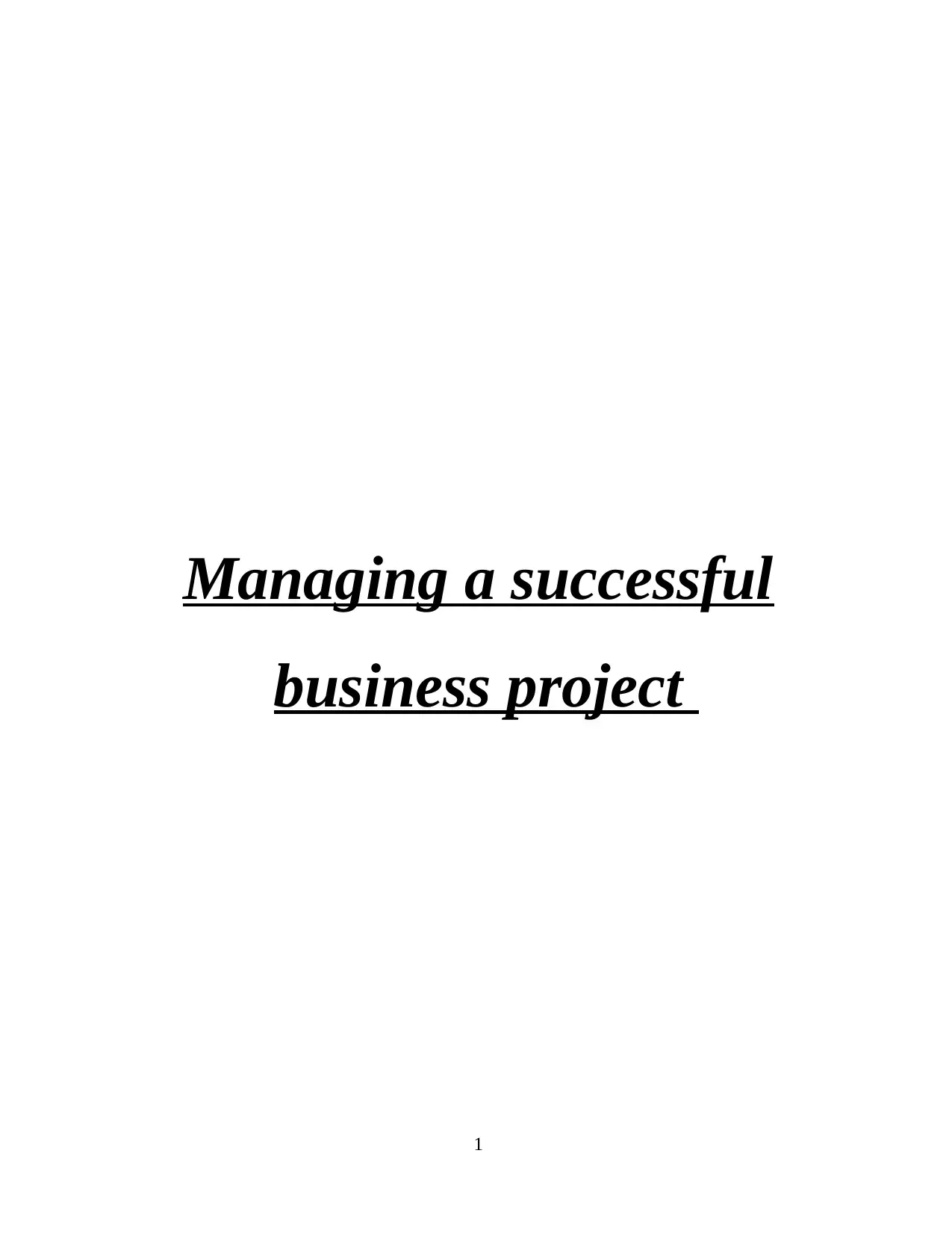
Managing a successful
business project
1
business project
1
Secure Best Marks with AI Grader
Need help grading? Try our AI Grader for instant feedback on your assignments.
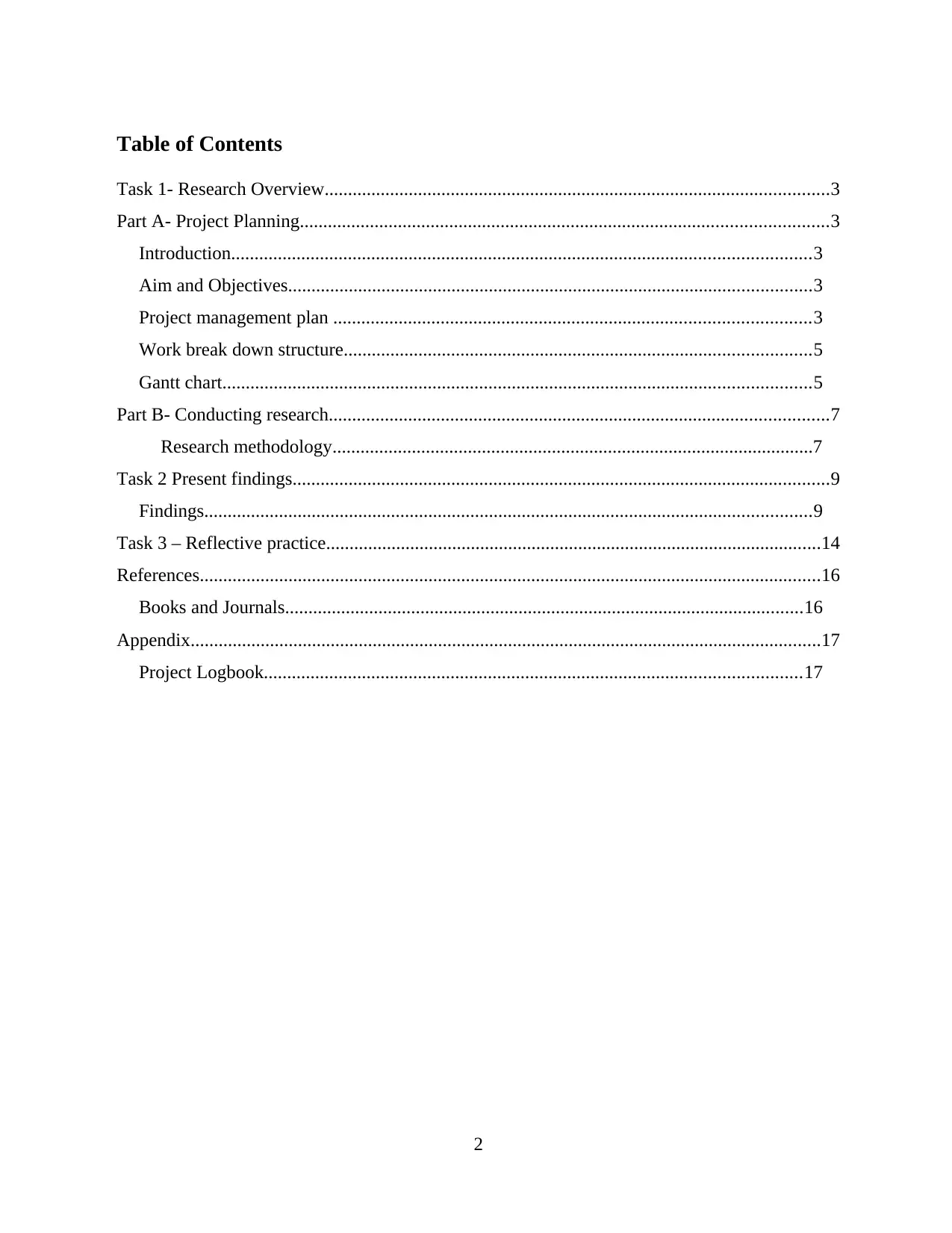
Table of Contents
Task 1- Research Overview............................................................................................................3
Part A- Project Planning.................................................................................................................3
Introduction............................................................................................................................3
Aim and Objectives................................................................................................................3
Project management plan ......................................................................................................3
Work break down structure....................................................................................................5
Gantt chart..............................................................................................................................5
Part B- Conducting research...........................................................................................................7
Research methodology.......................................................................................................7
Task 2 Present findings...................................................................................................................9
Findings..................................................................................................................................9
Task 3 – Reflective practice..........................................................................................................14
References.....................................................................................................................................16
Books and Journals...............................................................................................................16
Appendix.......................................................................................................................................17
Project Logbook...................................................................................................................17
2
Task 1- Research Overview............................................................................................................3
Part A- Project Planning.................................................................................................................3
Introduction............................................................................................................................3
Aim and Objectives................................................................................................................3
Project management plan ......................................................................................................3
Work break down structure....................................................................................................5
Gantt chart..............................................................................................................................5
Part B- Conducting research...........................................................................................................7
Research methodology.......................................................................................................7
Task 2 Present findings...................................................................................................................9
Findings..................................................................................................................................9
Task 3 – Reflective practice..........................................................................................................14
References.....................................................................................................................................16
Books and Journals...............................................................................................................16
Appendix.......................................................................................................................................17
Project Logbook...................................................................................................................17
2
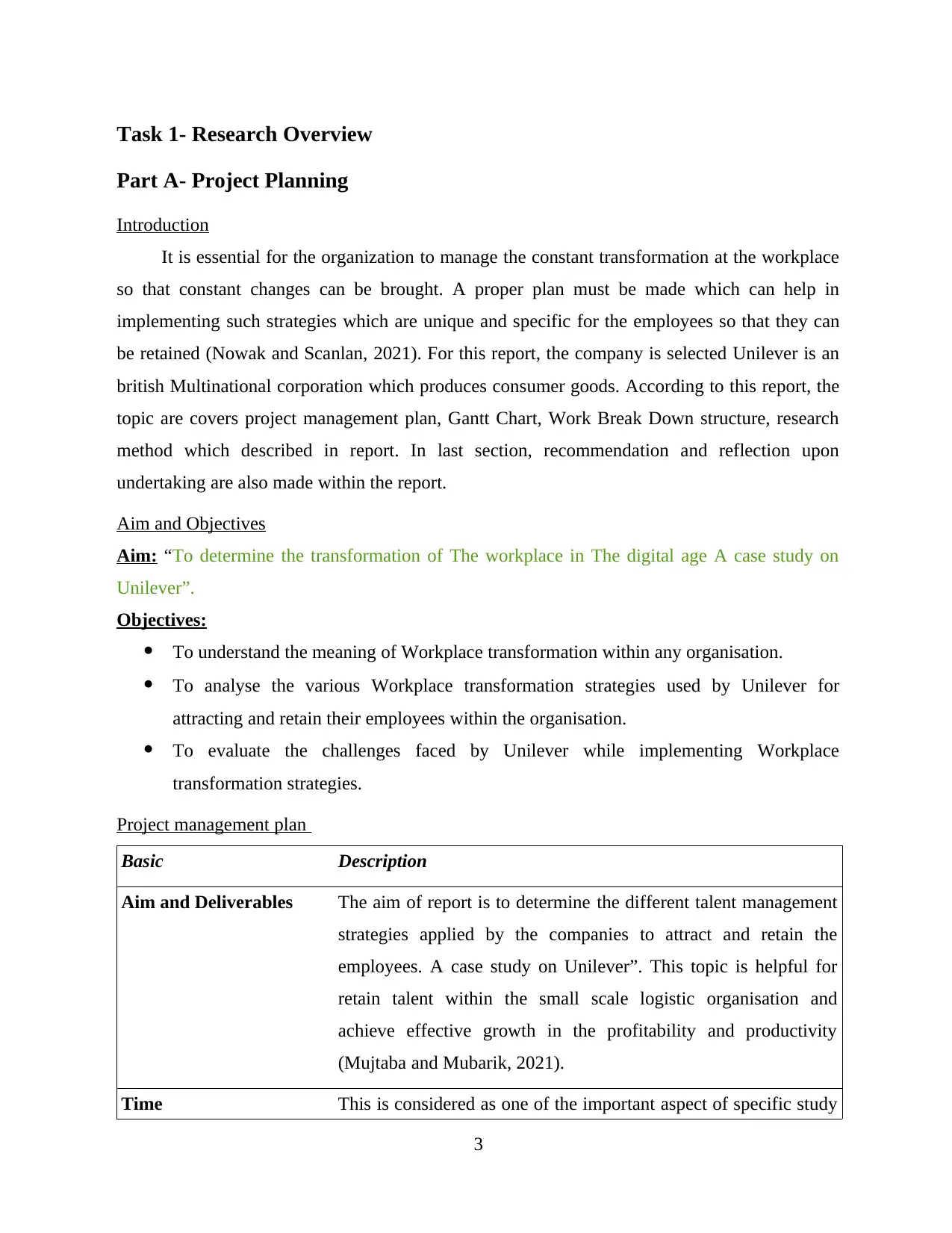
Task 1- Research Overview
Part A- Project Planning
Introduction
It is essential for the organization to manage the constant transformation at the workplace
so that constant changes can be brought. A proper plan must be made which can help in
implementing such strategies which are unique and specific for the employees so that they can
be retained (Nowak and Scanlan, 2021). For this report, the company is selected Unilever is an
british Multinational corporation which produces consumer goods. According to this report, the
topic are covers project management plan, Gantt Chart, Work Break Down structure, research
method which described in report. In last section, recommendation and reflection upon
undertaking are also made within the report.
Aim and Objectives
Aim: “To determine the transformation of The workplace in The digital age A case study on
Unilever”.
Objectives:
To understand the meaning of Workplace transformation within any organisation.
To analyse the various Workplace transformation strategies used by Unilever for
attracting and retain their employees within the organisation.
To evaluate the challenges faced by Unilever while implementing Workplace
transformation strategies.
Project management plan
Basic Description
Aim and Deliverables The aim of report is to determine the different talent management
strategies applied by the companies to attract and retain the
employees. A case study on Unilever”. This topic is helpful for
retain talent within the small scale logistic organisation and
achieve effective growth in the profitability and productivity
(Mujtaba and Mubarik, 2021).
Time This is considered as one of the important aspect of specific study
3
Part A- Project Planning
Introduction
It is essential for the organization to manage the constant transformation at the workplace
so that constant changes can be brought. A proper plan must be made which can help in
implementing such strategies which are unique and specific for the employees so that they can
be retained (Nowak and Scanlan, 2021). For this report, the company is selected Unilever is an
british Multinational corporation which produces consumer goods. According to this report, the
topic are covers project management plan, Gantt Chart, Work Break Down structure, research
method which described in report. In last section, recommendation and reflection upon
undertaking are also made within the report.
Aim and Objectives
Aim: “To determine the transformation of The workplace in The digital age A case study on
Unilever”.
Objectives:
To understand the meaning of Workplace transformation within any organisation.
To analyse the various Workplace transformation strategies used by Unilever for
attracting and retain their employees within the organisation.
To evaluate the challenges faced by Unilever while implementing Workplace
transformation strategies.
Project management plan
Basic Description
Aim and Deliverables The aim of report is to determine the different talent management
strategies applied by the companies to attract and retain the
employees. A case study on Unilever”. This topic is helpful for
retain talent within the small scale logistic organisation and
achieve effective growth in the profitability and productivity
(Mujtaba and Mubarik, 2021).
Time This is considered as one of the important aspect of specific study
3
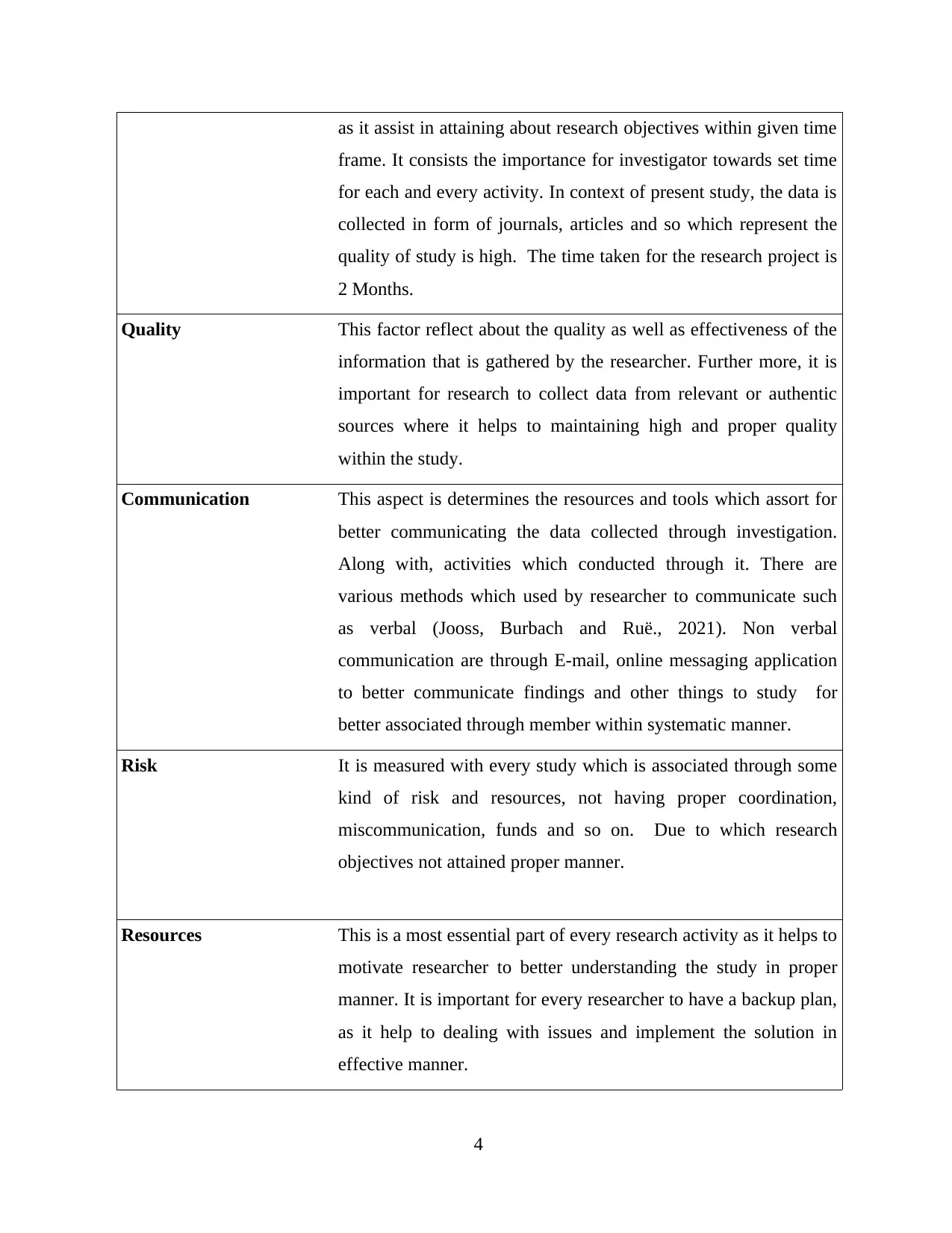
as it assist in attaining about research objectives within given time
frame. It consists the importance for investigator towards set time
for each and every activity. In context of present study, the data is
collected in form of journals, articles and so which represent the
quality of study is high. The time taken for the research project is
2 Months.
Quality This factor reflect about the quality as well as effectiveness of the
information that is gathered by the researcher. Further more, it is
important for research to collect data from relevant or authentic
sources where it helps to maintaining high and proper quality
within the study.
Communication This aspect is determines the resources and tools which assort for
better communicating the data collected through investigation.
Along with, activities which conducted through it. There are
various methods which used by researcher to communicate such
as verbal (Jooss, Burbach and Ruë., 2021). Non verbal
communication are through E-mail, online messaging application
to better communicate findings and other things to study for
better associated through member within systematic manner.
Risk It is measured with every study which is associated through some
kind of risk and resources, not having proper coordination,
miscommunication, funds and so on. Due to which research
objectives not attained proper manner.
Resources This is a most essential part of every research activity as it helps to
motivate researcher to better understanding the study in proper
manner. It is important for every researcher to have a backup plan,
as it help to dealing with issues and implement the solution in
effective manner.
4
frame. It consists the importance for investigator towards set time
for each and every activity. In context of present study, the data is
collected in form of journals, articles and so which represent the
quality of study is high. The time taken for the research project is
2 Months.
Quality This factor reflect about the quality as well as effectiveness of the
information that is gathered by the researcher. Further more, it is
important for research to collect data from relevant or authentic
sources where it helps to maintaining high and proper quality
within the study.
Communication This aspect is determines the resources and tools which assort for
better communicating the data collected through investigation.
Along with, activities which conducted through it. There are
various methods which used by researcher to communicate such
as verbal (Jooss, Burbach and Ruë., 2021). Non verbal
communication are through E-mail, online messaging application
to better communicate findings and other things to study for
better associated through member within systematic manner.
Risk It is measured with every study which is associated through some
kind of risk and resources, not having proper coordination,
miscommunication, funds and so on. Due to which research
objectives not attained proper manner.
Resources This is a most essential part of every research activity as it helps to
motivate researcher to better understanding the study in proper
manner. It is important for every researcher to have a backup plan,
as it help to dealing with issues and implement the solution in
effective manner.
4
Secure Best Marks with AI Grader
Need help grading? Try our AI Grader for instant feedback on your assignments.
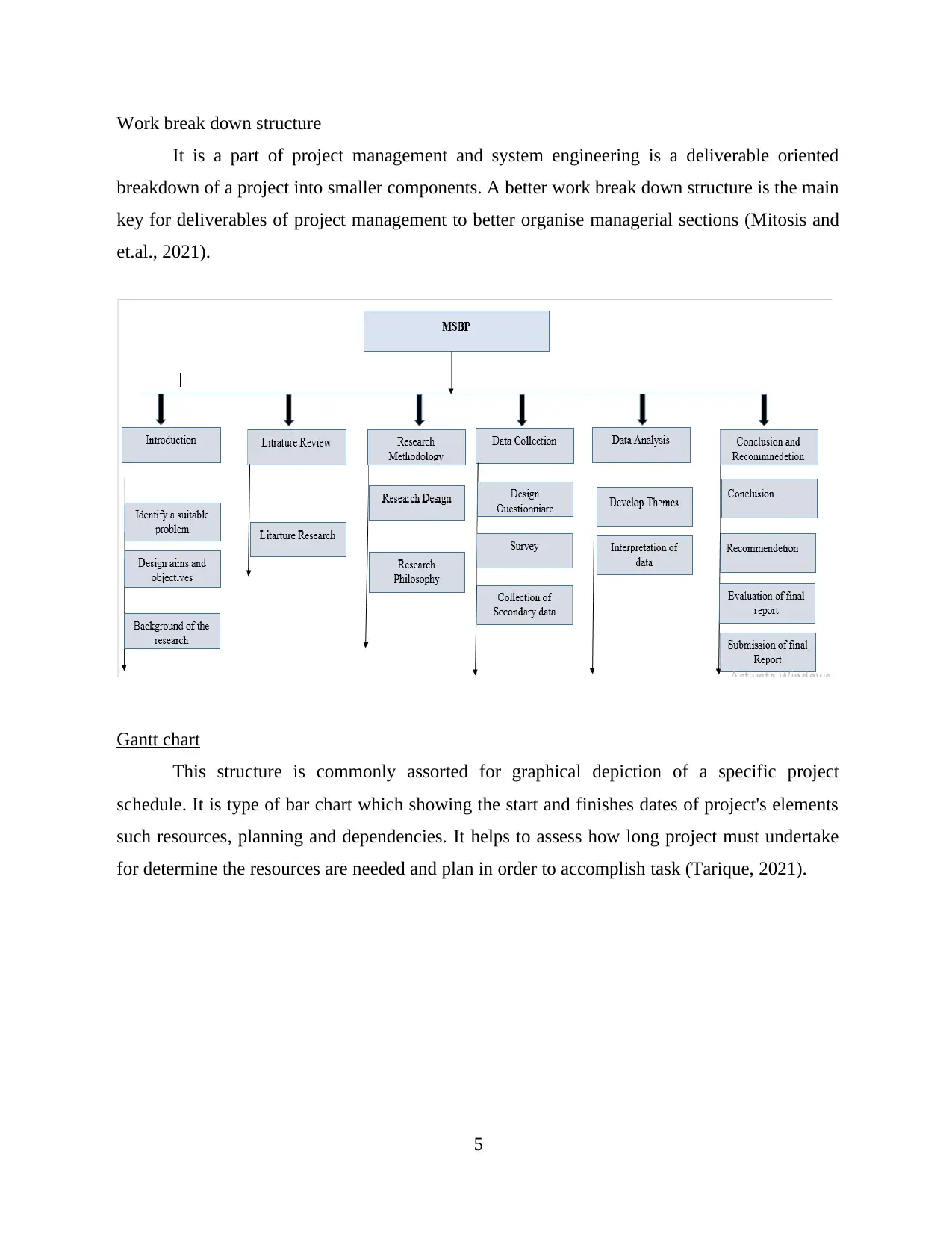
Work break down structure
It is a part of project management and system engineering is a deliverable oriented
breakdown of a project into smaller components. A better work break down structure is the main
key for deliverables of project management to better organise managerial sections (Mitosis and
et.al., 2021).
Gantt chart
This structure is commonly assorted for graphical depiction of a specific project
schedule. It is type of bar chart which showing the start and finishes dates of project's elements
such resources, planning and dependencies. It helps to assess how long project must undertake
for determine the resources are needed and plan in order to accomplish task (Tarique, 2021).
5
It is a part of project management and system engineering is a deliverable oriented
breakdown of a project into smaller components. A better work break down structure is the main
key for deliverables of project management to better organise managerial sections (Mitosis and
et.al., 2021).
Gantt chart
This structure is commonly assorted for graphical depiction of a specific project
schedule. It is type of bar chart which showing the start and finishes dates of project's elements
such resources, planning and dependencies. It helps to assess how long project must undertake
for determine the resources are needed and plan in order to accomplish task (Tarique, 2021).
5
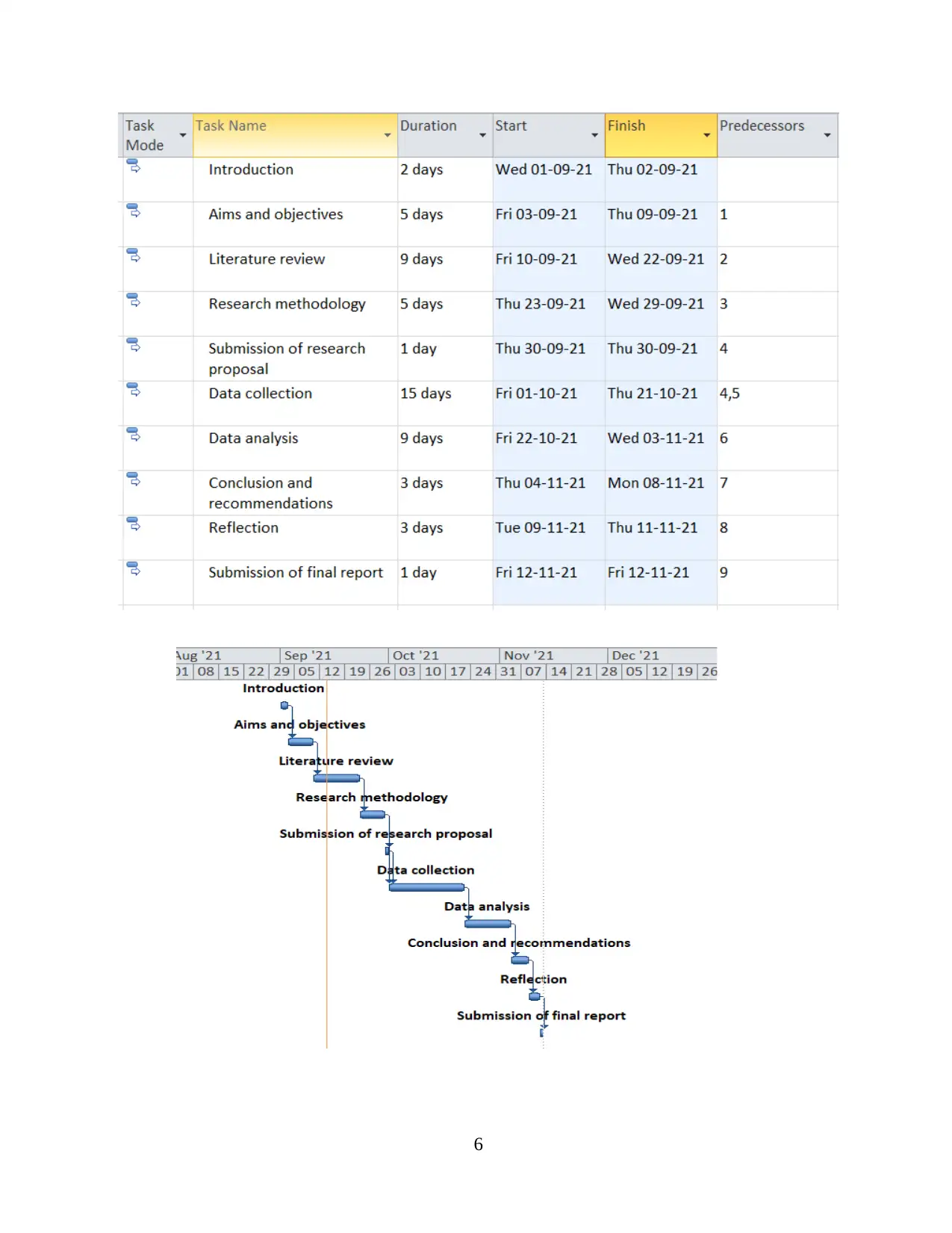
6
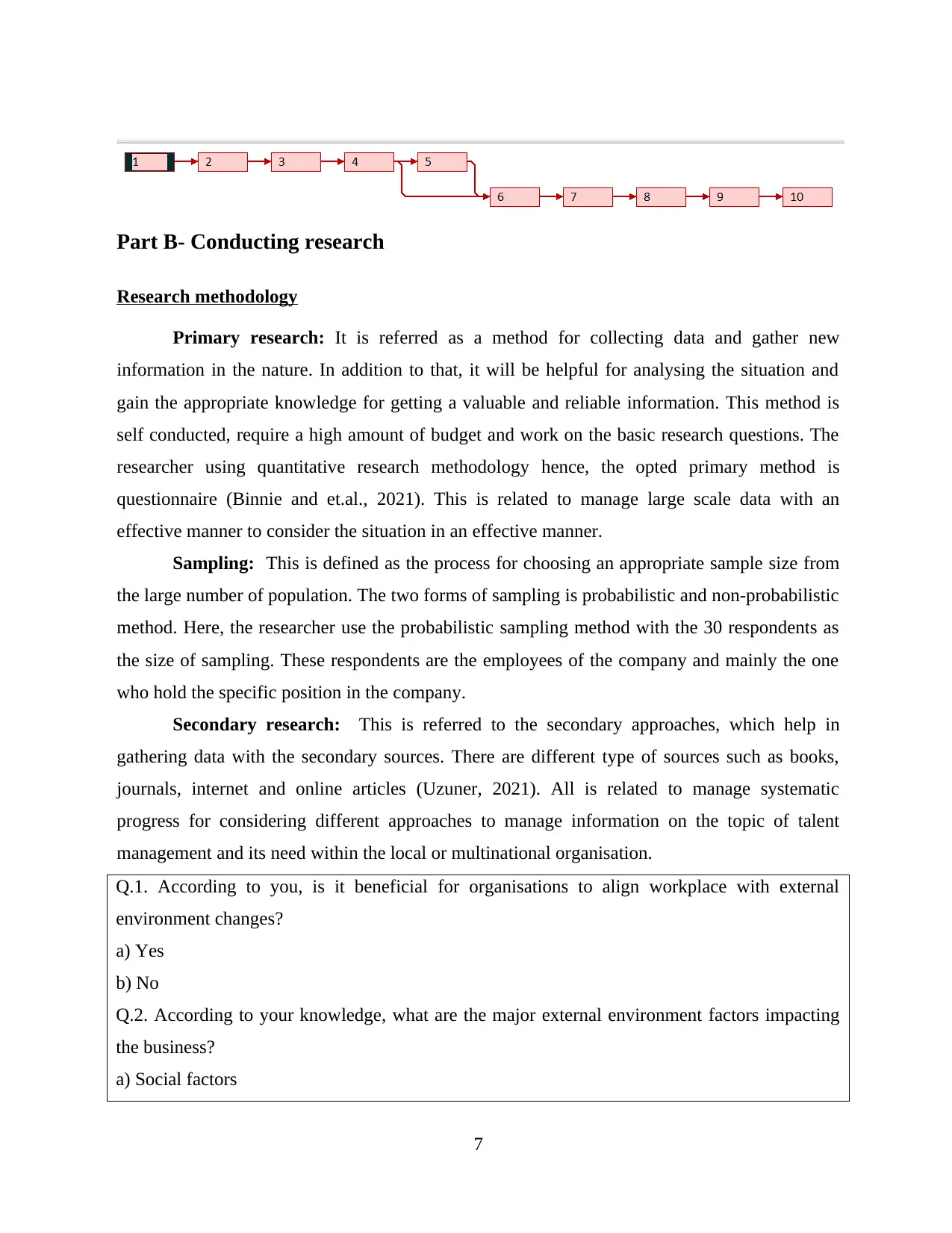
Part B- Conducting research
Research methodology
Primary research: It is referred as a method for collecting data and gather new
information in the nature. In addition to that, it will be helpful for analysing the situation and
gain the appropriate knowledge for getting a valuable and reliable information. This method is
self conducted, require a high amount of budget and work on the basic research questions. The
researcher using quantitative research methodology hence, the opted primary method is
questionnaire (Binnie and et.al., 2021). This is related to manage large scale data with an
effective manner to consider the situation in an effective manner.
Sampling: This is defined as the process for choosing an appropriate sample size from
the large number of population. The two forms of sampling is probabilistic and non-probabilistic
method. Here, the researcher use the probabilistic sampling method with the 30 respondents as
the size of sampling. These respondents are the employees of the company and mainly the one
who hold the specific position in the company.
Secondary research: This is referred to the secondary approaches, which help in
gathering data with the secondary sources. There are different type of sources such as books,
journals, internet and online articles (Uzuner, 2021). All is related to manage systematic
progress for considering different approaches to manage information on the topic of talent
management and its need within the local or multinational organisation.
Q.1. According to you, is it beneficial for organisations to align workplace with external
environment changes?
a) Yes
b) No
Q.2. According to your knowledge, what are the major external environment factors impacting
the business?
a) Social factors
7
Research methodology
Primary research: It is referred as a method for collecting data and gather new
information in the nature. In addition to that, it will be helpful for analysing the situation and
gain the appropriate knowledge for getting a valuable and reliable information. This method is
self conducted, require a high amount of budget and work on the basic research questions. The
researcher using quantitative research methodology hence, the opted primary method is
questionnaire (Binnie and et.al., 2021). This is related to manage large scale data with an
effective manner to consider the situation in an effective manner.
Sampling: This is defined as the process for choosing an appropriate sample size from
the large number of population. The two forms of sampling is probabilistic and non-probabilistic
method. Here, the researcher use the probabilistic sampling method with the 30 respondents as
the size of sampling. These respondents are the employees of the company and mainly the one
who hold the specific position in the company.
Secondary research: This is referred to the secondary approaches, which help in
gathering data with the secondary sources. There are different type of sources such as books,
journals, internet and online articles (Uzuner, 2021). All is related to manage systematic
progress for considering different approaches to manage information on the topic of talent
management and its need within the local or multinational organisation.
Q.1. According to you, is it beneficial for organisations to align workplace with external
environment changes?
a) Yes
b) No
Q.2. According to your knowledge, what are the major external environment factors impacting
the business?
a) Social factors
7
Paraphrase This Document
Need a fresh take? Get an instant paraphrase of this document with our AI Paraphraser
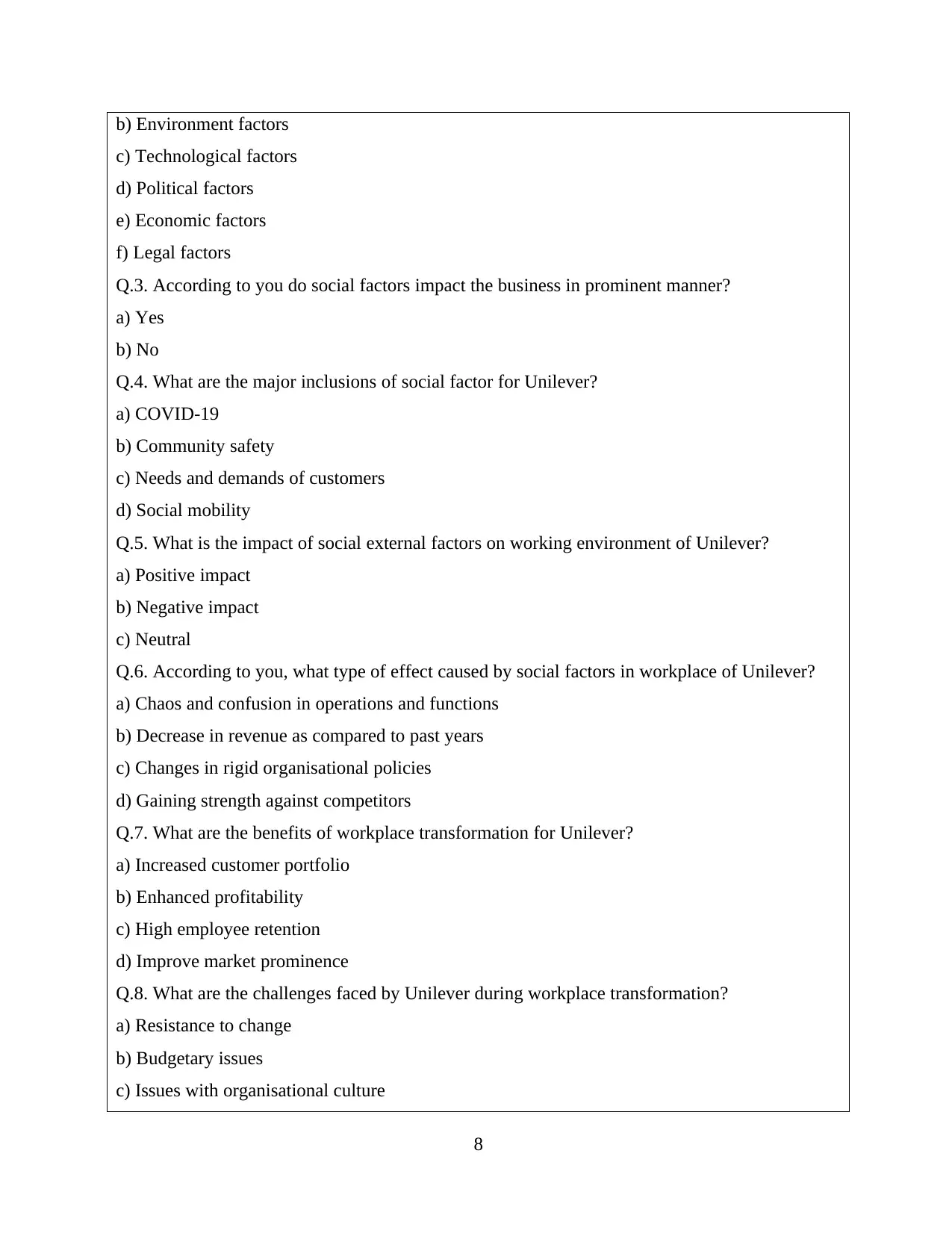
b) Environment factors
c) Technological factors
d) Political factors
e) Economic factors
f) Legal factors
Q.3. According to you do social factors impact the business in prominent manner?
a) Yes
b) No
Q.4. What are the major inclusions of social factor for Unilever?
a) COVID-19
b) Community safety
c) Needs and demands of customers
d) Social mobility
Q.5. What is the impact of social external factors on working environment of Unilever?
a) Positive impact
b) Negative impact
c) Neutral
Q.6. According to you, what type of effect caused by social factors in workplace of Unilever?
a) Chaos and confusion in operations and functions
b) Decrease in revenue as compared to past years
c) Changes in rigid organisational policies
d) Gaining strength against competitors
Q.7. What are the benefits of workplace transformation for Unilever?
a) Increased customer portfolio
b) Enhanced profitability
c) High employee retention
d) Improve market prominence
Q.8. What are the challenges faced by Unilever during workplace transformation?
a) Resistance to change
b) Budgetary issues
c) Issues with organisational culture
8
c) Technological factors
d) Political factors
e) Economic factors
f) Legal factors
Q.3. According to you do social factors impact the business in prominent manner?
a) Yes
b) No
Q.4. What are the major inclusions of social factor for Unilever?
a) COVID-19
b) Community safety
c) Needs and demands of customers
d) Social mobility
Q.5. What is the impact of social external factors on working environment of Unilever?
a) Positive impact
b) Negative impact
c) Neutral
Q.6. According to you, what type of effect caused by social factors in workplace of Unilever?
a) Chaos and confusion in operations and functions
b) Decrease in revenue as compared to past years
c) Changes in rigid organisational policies
d) Gaining strength against competitors
Q.7. What are the benefits of workplace transformation for Unilever?
a) Increased customer portfolio
b) Enhanced profitability
c) High employee retention
d) Improve market prominence
Q.8. What are the challenges faced by Unilever during workplace transformation?
a) Resistance to change
b) Budgetary issues
c) Issues with organisational culture
8
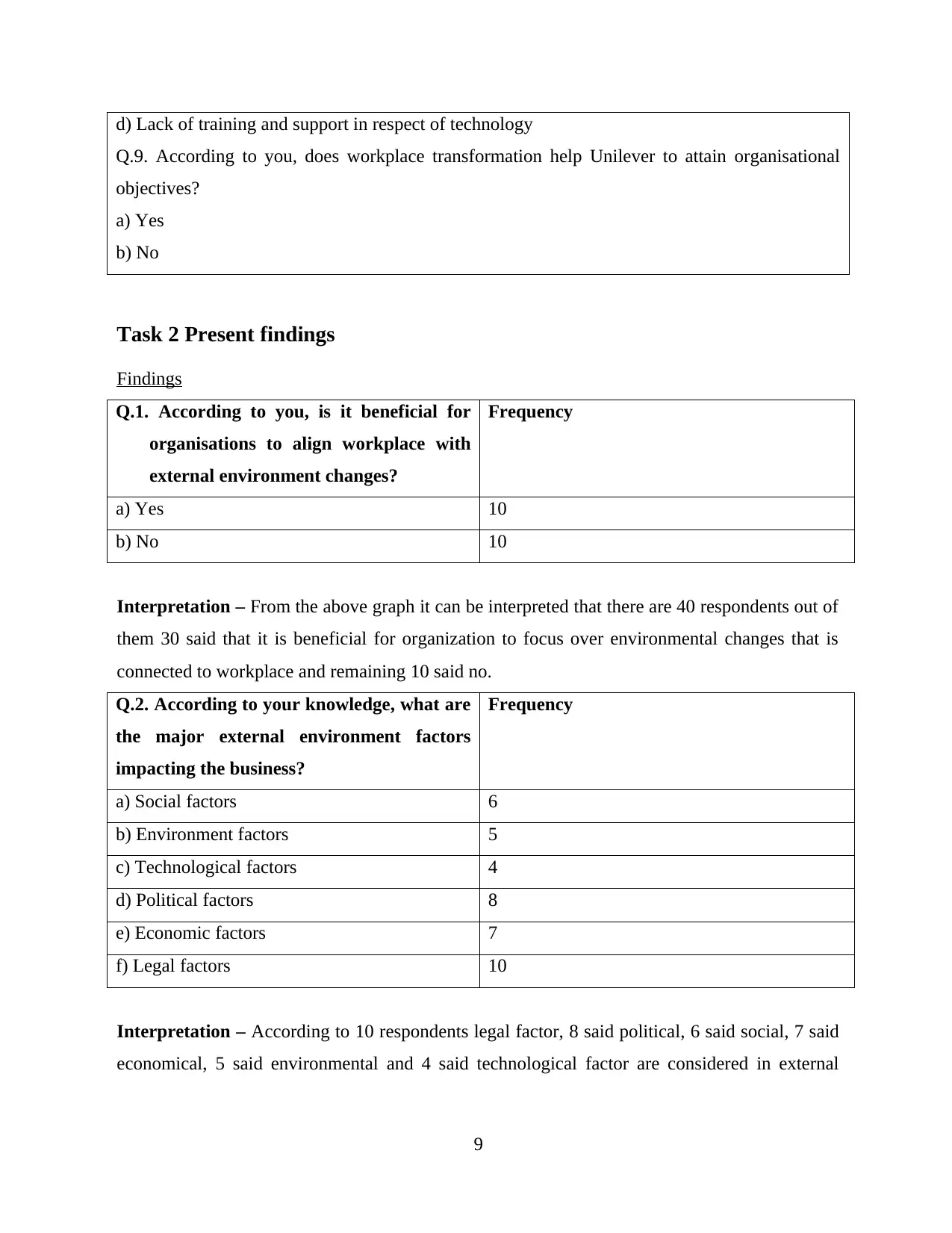
d) Lack of training and support in respect of technology
Q.9. According to you, does workplace transformation help Unilever to attain organisational
objectives?
a) Yes
b) No
Task 2 Present findings
Findings
Q.1. According to you, is it beneficial for
organisations to align workplace with
external environment changes?
Frequency
a) Yes 10
b) No 10
Interpretation – From the above graph it can be interpreted that there are 40 respondents out of
them 30 said that it is beneficial for organization to focus over environmental changes that is
connected to workplace and remaining 10 said no.
Q.2. According to your knowledge, what are
the major external environment factors
impacting the business?
Frequency
a) Social factors 6
b) Environment factors 5
c) Technological factors 4
d) Political factors 8
e) Economic factors 7
f) Legal factors 10
Interpretation – According to 10 respondents legal factor, 8 said political, 6 said social, 7 said
economical, 5 said environmental and 4 said technological factor are considered in external
9
Q.9. According to you, does workplace transformation help Unilever to attain organisational
objectives?
a) Yes
b) No
Task 2 Present findings
Findings
Q.1. According to you, is it beneficial for
organisations to align workplace with
external environment changes?
Frequency
a) Yes 10
b) No 10
Interpretation – From the above graph it can be interpreted that there are 40 respondents out of
them 30 said that it is beneficial for organization to focus over environmental changes that is
connected to workplace and remaining 10 said no.
Q.2. According to your knowledge, what are
the major external environment factors
impacting the business?
Frequency
a) Social factors 6
b) Environment factors 5
c) Technological factors 4
d) Political factors 8
e) Economic factors 7
f) Legal factors 10
Interpretation – According to 10 respondents legal factor, 8 said political, 6 said social, 7 said
economical, 5 said environmental and 4 said technological factor are considered in external
9
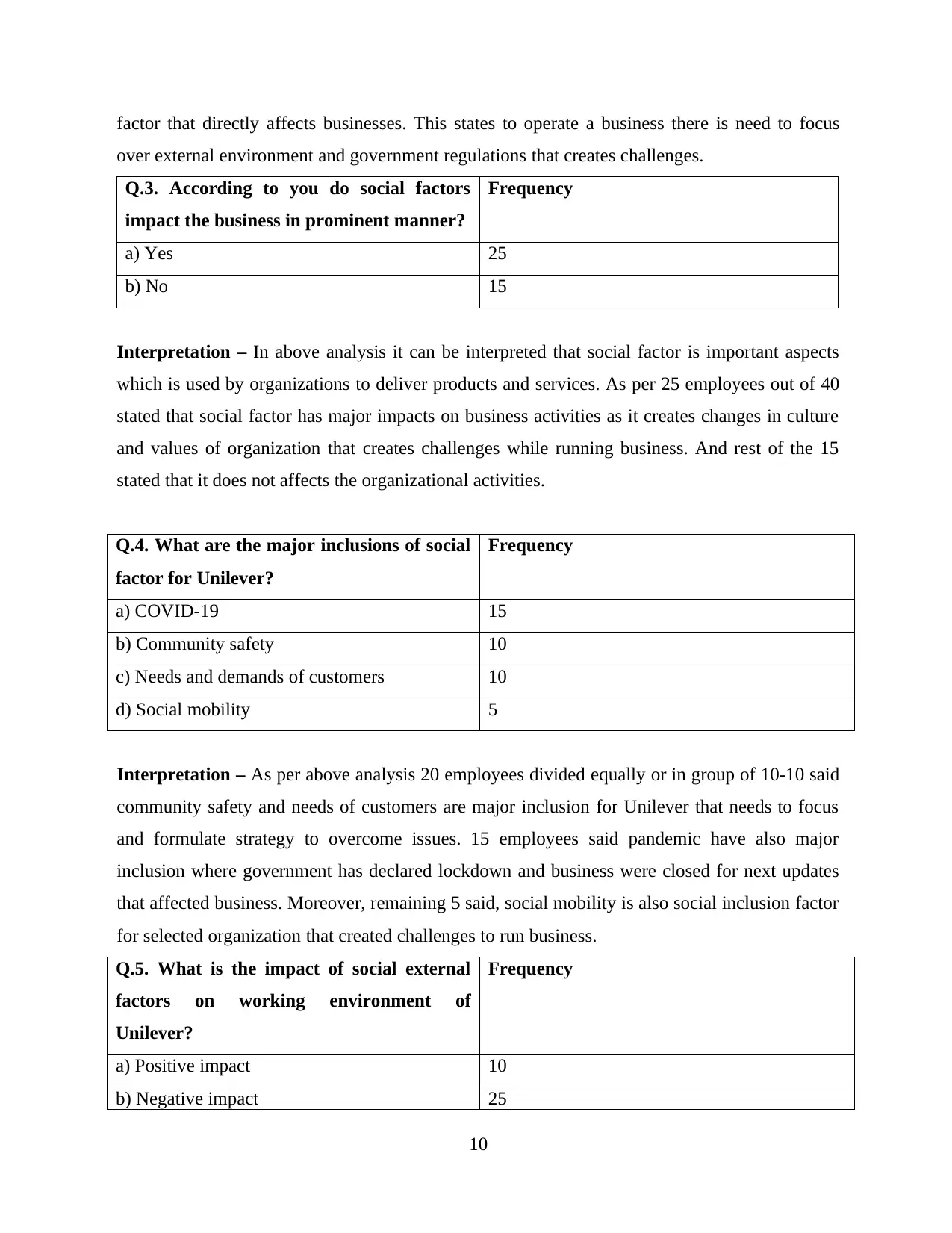
factor that directly affects businesses. This states to operate a business there is need to focus
over external environment and government regulations that creates challenges.
Q.3. According to you do social factors
impact the business in prominent manner?
Frequency
a) Yes 25
b) No 15
Interpretation – In above analysis it can be interpreted that social factor is important aspects
which is used by organizations to deliver products and services. As per 25 employees out of 40
stated that social factor has major impacts on business activities as it creates changes in culture
and values of organization that creates challenges while running business. And rest of the 15
stated that it does not affects the organizational activities.
Q.4. What are the major inclusions of social
factor for Unilever?
Frequency
a) COVID-19 15
b) Community safety 10
c) Needs and demands of customers 10
d) Social mobility 5
Interpretation – As per above analysis 20 employees divided equally or in group of 10-10 said
community safety and needs of customers are major inclusion for Unilever that needs to focus
and formulate strategy to overcome issues. 15 employees said pandemic have also major
inclusion where government has declared lockdown and business were closed for next updates
that affected business. Moreover, remaining 5 said, social mobility is also social inclusion factor
for selected organization that created challenges to run business.
Q.5. What is the impact of social external
factors on working environment of
Unilever?
Frequency
a) Positive impact 10
b) Negative impact 25
10
over external environment and government regulations that creates challenges.
Q.3. According to you do social factors
impact the business in prominent manner?
Frequency
a) Yes 25
b) No 15
Interpretation – In above analysis it can be interpreted that social factor is important aspects
which is used by organizations to deliver products and services. As per 25 employees out of 40
stated that social factor has major impacts on business activities as it creates changes in culture
and values of organization that creates challenges while running business. And rest of the 15
stated that it does not affects the organizational activities.
Q.4. What are the major inclusions of social
factor for Unilever?
Frequency
a) COVID-19 15
b) Community safety 10
c) Needs and demands of customers 10
d) Social mobility 5
Interpretation – As per above analysis 20 employees divided equally or in group of 10-10 said
community safety and needs of customers are major inclusion for Unilever that needs to focus
and formulate strategy to overcome issues. 15 employees said pandemic have also major
inclusion where government has declared lockdown and business were closed for next updates
that affected business. Moreover, remaining 5 said, social mobility is also social inclusion factor
for selected organization that created challenges to run business.
Q.5. What is the impact of social external
factors on working environment of
Unilever?
Frequency
a) Positive impact 10
b) Negative impact 25
10
Secure Best Marks with AI Grader
Need help grading? Try our AI Grader for instant feedback on your assignments.
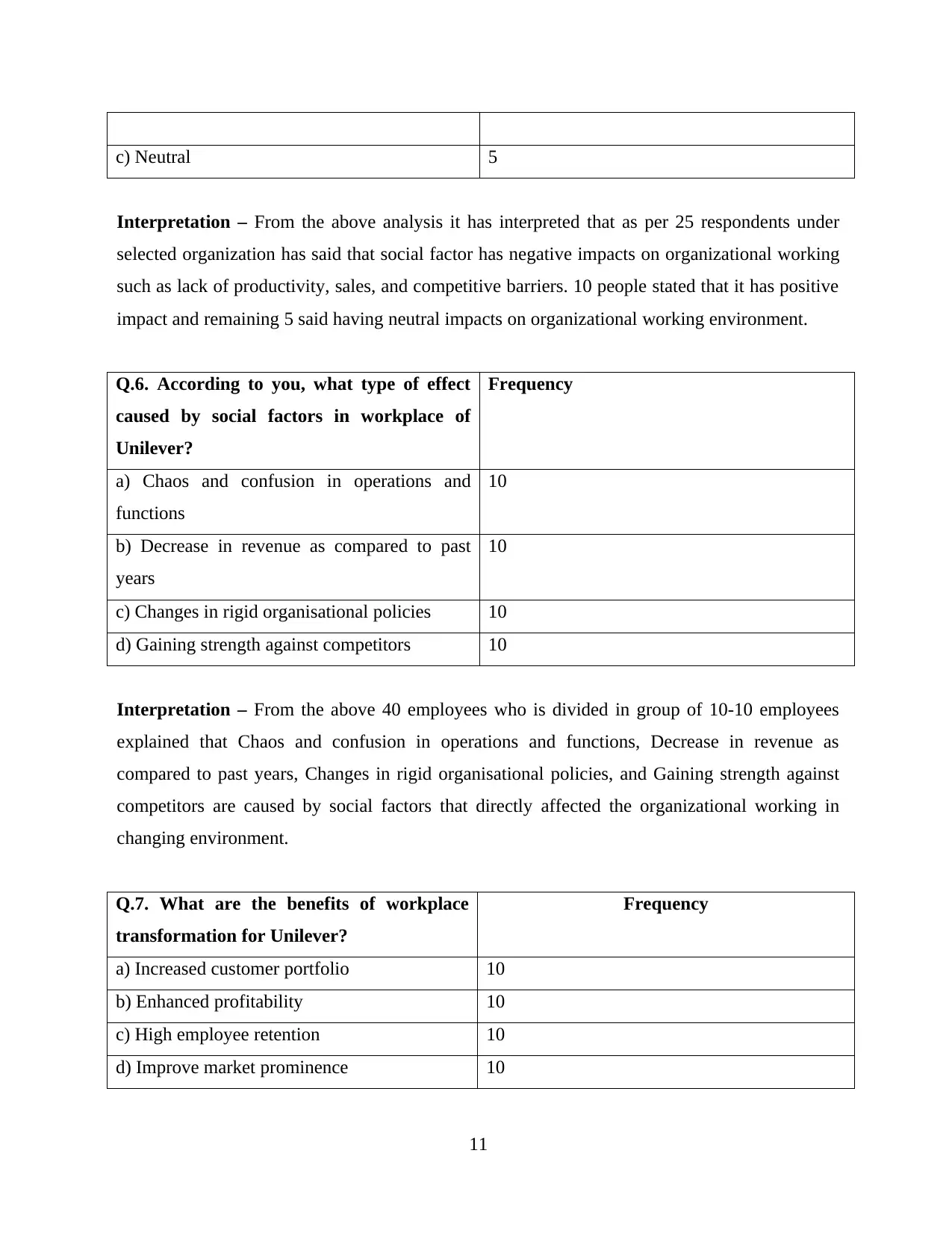
c) Neutral 5
Interpretation – From the above analysis it has interpreted that as per 25 respondents under
selected organization has said that social factor has negative impacts on organizational working
such as lack of productivity, sales, and competitive barriers. 10 people stated that it has positive
impact and remaining 5 said having neutral impacts on organizational working environment.
Q.6. According to you, what type of effect
caused by social factors in workplace of
Unilever?
Frequency
a) Chaos and confusion in operations and
functions
10
b) Decrease in revenue as compared to past
years
10
c) Changes in rigid organisational policies 10
d) Gaining strength against competitors 10
Interpretation – From the above 40 employees who is divided in group of 10-10 employees
explained that Chaos and confusion in operations and functions, Decrease in revenue as
compared to past years, Changes in rigid organisational policies, and Gaining strength against
competitors are caused by social factors that directly affected the organizational working in
changing environment.
Q.7. What are the benefits of workplace
transformation for Unilever?
Frequency
a) Increased customer portfolio 10
b) Enhanced profitability 10
c) High employee retention 10
d) Improve market prominence 10
11
Interpretation – From the above analysis it has interpreted that as per 25 respondents under
selected organization has said that social factor has negative impacts on organizational working
such as lack of productivity, sales, and competitive barriers. 10 people stated that it has positive
impact and remaining 5 said having neutral impacts on organizational working environment.
Q.6. According to you, what type of effect
caused by social factors in workplace of
Unilever?
Frequency
a) Chaos and confusion in operations and
functions
10
b) Decrease in revenue as compared to past
years
10
c) Changes in rigid organisational policies 10
d) Gaining strength against competitors 10
Interpretation – From the above 40 employees who is divided in group of 10-10 employees
explained that Chaos and confusion in operations and functions, Decrease in revenue as
compared to past years, Changes in rigid organisational policies, and Gaining strength against
competitors are caused by social factors that directly affected the organizational working in
changing environment.
Q.7. What are the benefits of workplace
transformation for Unilever?
Frequency
a) Increased customer portfolio 10
b) Enhanced profitability 10
c) High employee retention 10
d) Improve market prominence 10
11
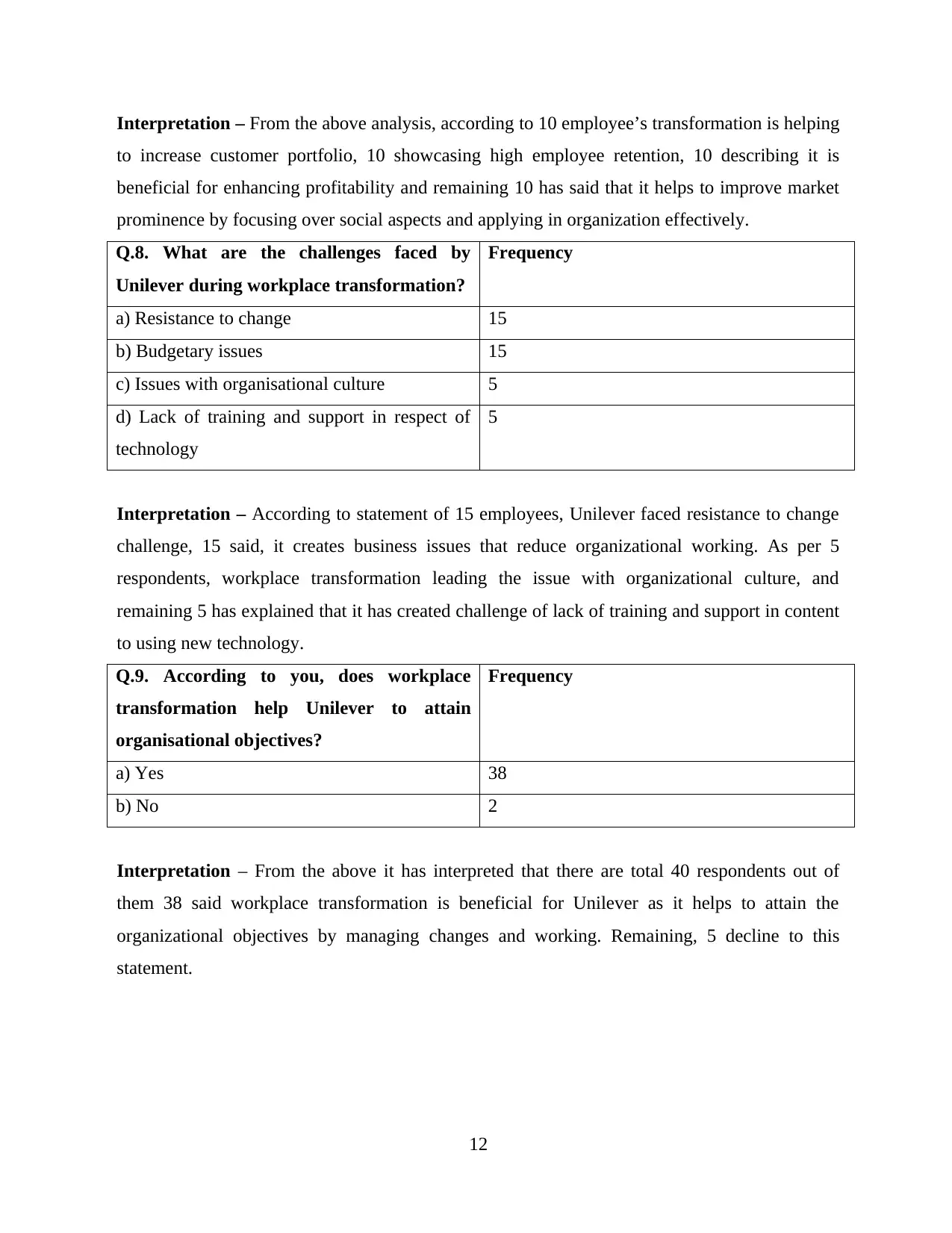
Interpretation – From the above analysis, according to 10 employee’s transformation is helping
to increase customer portfolio, 10 showcasing high employee retention, 10 describing it is
beneficial for enhancing profitability and remaining 10 has said that it helps to improve market
prominence by focusing over social aspects and applying in organization effectively.
Q.8. What are the challenges faced by
Unilever during workplace transformation?
Frequency
a) Resistance to change 15
b) Budgetary issues 15
c) Issues with organisational culture 5
d) Lack of training and support in respect of
technology
5
Interpretation – According to statement of 15 employees, Unilever faced resistance to change
challenge, 15 said, it creates business issues that reduce organizational working. As per 5
respondents, workplace transformation leading the issue with organizational culture, and
remaining 5 has explained that it has created challenge of lack of training and support in content
to using new technology.
Q.9. According to you, does workplace
transformation help Unilever to attain
organisational objectives?
Frequency
a) Yes 38
b) No 2
Interpretation – From the above it has interpreted that there are total 40 respondents out of
them 38 said workplace transformation is beneficial for Unilever as it helps to attain the
organizational objectives by managing changes and working. Remaining, 5 decline to this
statement.
12
to increase customer portfolio, 10 showcasing high employee retention, 10 describing it is
beneficial for enhancing profitability and remaining 10 has said that it helps to improve market
prominence by focusing over social aspects and applying in organization effectively.
Q.8. What are the challenges faced by
Unilever during workplace transformation?
Frequency
a) Resistance to change 15
b) Budgetary issues 15
c) Issues with organisational culture 5
d) Lack of training and support in respect of
technology
5
Interpretation – According to statement of 15 employees, Unilever faced resistance to change
challenge, 15 said, it creates business issues that reduce organizational working. As per 5
respondents, workplace transformation leading the issue with organizational culture, and
remaining 5 has explained that it has created challenge of lack of training and support in content
to using new technology.
Q.9. According to you, does workplace
transformation help Unilever to attain
organisational objectives?
Frequency
a) Yes 38
b) No 2
Interpretation – From the above it has interpreted that there are total 40 respondents out of
them 38 said workplace transformation is beneficial for Unilever as it helps to attain the
organizational objectives by managing changes and working. Remaining, 5 decline to this
statement.
12
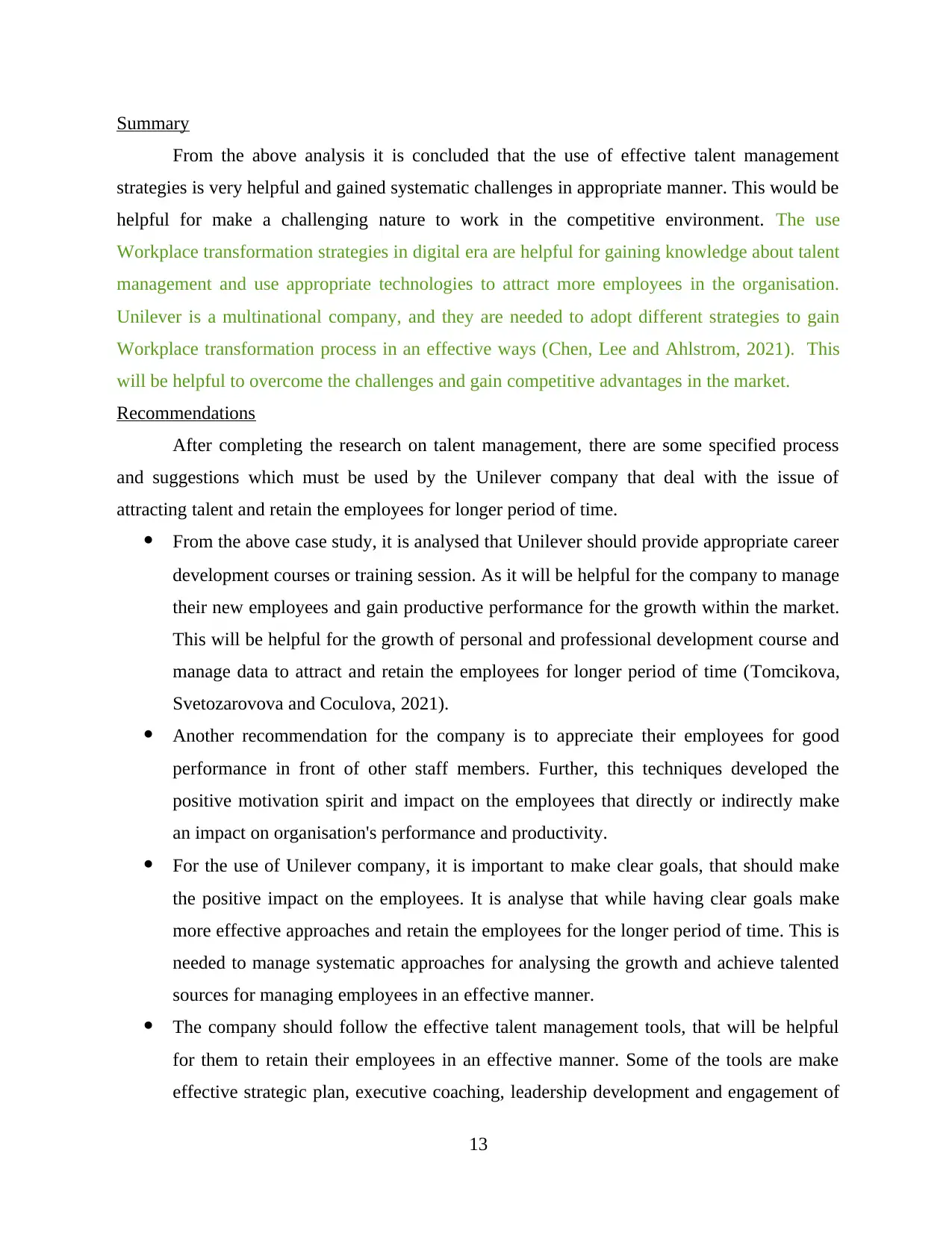
Summary
From the above analysis it is concluded that the use of effective talent management
strategies is very helpful and gained systematic challenges in appropriate manner. This would be
helpful for make a challenging nature to work in the competitive environment. The use
Workplace transformation strategies in digital era are helpful for gaining knowledge about talent
management and use appropriate technologies to attract more employees in the organisation.
Unilever is a multinational company, and they are needed to adopt different strategies to gain
Workplace transformation process in an effective ways (Chen, Lee and Ahlstrom, 2021). This
will be helpful to overcome the challenges and gain competitive advantages in the market.
Recommendations
After completing the research on talent management, there are some specified process
and suggestions which must be used by the Unilever company that deal with the issue of
attracting talent and retain the employees for longer period of time.
From the above case study, it is analysed that Unilever should provide appropriate career
development courses or training session. As it will be helpful for the company to manage
their new employees and gain productive performance for the growth within the market.
This will be helpful for the growth of personal and professional development course and
manage data to attract and retain the employees for longer period of time (Tomcikova,
Svetozarovova and Coculova, 2021).
Another recommendation for the company is to appreciate their employees for good
performance in front of other staff members. Further, this techniques developed the
positive motivation spirit and impact on the employees that directly or indirectly make
an impact on organisation's performance and productivity.
For the use of Unilever company, it is important to make clear goals, that should make
the positive impact on the employees. It is analyse that while having clear goals make
more effective approaches and retain the employees for the longer period of time. This is
needed to manage systematic approaches for analysing the growth and achieve talented
sources for managing employees in an effective manner.
The company should follow the effective talent management tools, that will be helpful
for them to retain their employees in an effective manner. Some of the tools are make
effective strategic plan, executive coaching, leadership development and engagement of
13
From the above analysis it is concluded that the use of effective talent management
strategies is very helpful and gained systematic challenges in appropriate manner. This would be
helpful for make a challenging nature to work in the competitive environment. The use
Workplace transformation strategies in digital era are helpful for gaining knowledge about talent
management and use appropriate technologies to attract more employees in the organisation.
Unilever is a multinational company, and they are needed to adopt different strategies to gain
Workplace transformation process in an effective ways (Chen, Lee and Ahlstrom, 2021). This
will be helpful to overcome the challenges and gain competitive advantages in the market.
Recommendations
After completing the research on talent management, there are some specified process
and suggestions which must be used by the Unilever company that deal with the issue of
attracting talent and retain the employees for longer period of time.
From the above case study, it is analysed that Unilever should provide appropriate career
development courses or training session. As it will be helpful for the company to manage
their new employees and gain productive performance for the growth within the market.
This will be helpful for the growth of personal and professional development course and
manage data to attract and retain the employees for longer period of time (Tomcikova,
Svetozarovova and Coculova, 2021).
Another recommendation for the company is to appreciate their employees for good
performance in front of other staff members. Further, this techniques developed the
positive motivation spirit and impact on the employees that directly or indirectly make
an impact on organisation's performance and productivity.
For the use of Unilever company, it is important to make clear goals, that should make
the positive impact on the employees. It is analyse that while having clear goals make
more effective approaches and retain the employees for the longer period of time. This is
needed to manage systematic approaches for analysing the growth and achieve talented
sources for managing employees in an effective manner.
The company should follow the effective talent management tools, that will be helpful
for them to retain their employees in an effective manner. Some of the tools are make
effective strategic plan, executive coaching, leadership development and engagement of
13
Paraphrase This Document
Need a fresh take? Get an instant paraphrase of this document with our AI Paraphraser
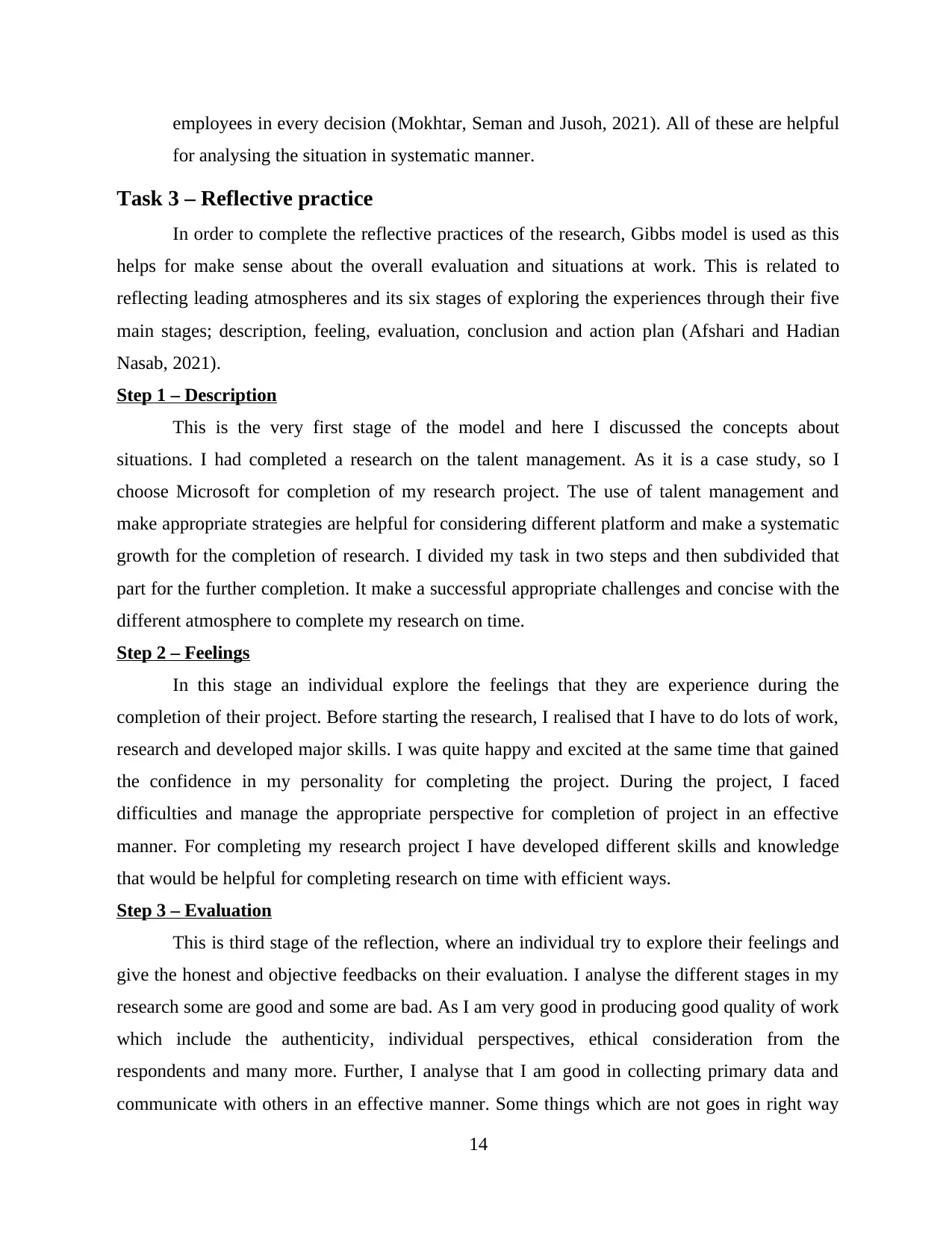
employees in every decision (Mokhtar, Seman and Jusoh, 2021). All of these are helpful
for analysing the situation in systematic manner.
Task 3 – Reflective practice
In order to complete the reflective practices of the research, Gibbs model is used as this
helps for make sense about the overall evaluation and situations at work. This is related to
reflecting leading atmospheres and its six stages of exploring the experiences through their five
main stages; description, feeling, evaluation, conclusion and action plan (Afshari and Hadian
Nasab, 2021).
Step 1 – Description
This is the very first stage of the model and here I discussed the concepts about
situations. I had completed a research on the talent management. As it is a case study, so I
choose Microsoft for completion of my research project. The use of talent management and
make appropriate strategies are helpful for considering different platform and make a systematic
growth for the completion of research. I divided my task in two steps and then subdivided that
part for the further completion. It make a successful appropriate challenges and concise with the
different atmosphere to complete my research on time.
Step 2 – Feelings
In this stage an individual explore the feelings that they are experience during the
completion of their project. Before starting the research, I realised that I have to do lots of work,
research and developed major skills. I was quite happy and excited at the same time that gained
the confidence in my personality for completing the project. During the project, I faced
difficulties and manage the appropriate perspective for completion of project in an effective
manner. For completing my research project I have developed different skills and knowledge
that would be helpful for completing research on time with efficient ways.
Step 3 – Evaluation
This is third stage of the reflection, where an individual try to explore their feelings and
give the honest and objective feedbacks on their evaluation. I analyse the different stages in my
research some are good and some are bad. As I am very good in producing good quality of work
which include the authenticity, individual perspectives, ethical consideration from the
respondents and many more. Further, I analyse that I am good in collecting primary data and
communicate with others in an effective manner. Some things which are not goes in right way
14
for analysing the situation in systematic manner.
Task 3 – Reflective practice
In order to complete the reflective practices of the research, Gibbs model is used as this
helps for make sense about the overall evaluation and situations at work. This is related to
reflecting leading atmospheres and its six stages of exploring the experiences through their five
main stages; description, feeling, evaluation, conclusion and action plan (Afshari and Hadian
Nasab, 2021).
Step 1 – Description
This is the very first stage of the model and here I discussed the concepts about
situations. I had completed a research on the talent management. As it is a case study, so I
choose Microsoft for completion of my research project. The use of talent management and
make appropriate strategies are helpful for considering different platform and make a systematic
growth for the completion of research. I divided my task in two steps and then subdivided that
part for the further completion. It make a successful appropriate challenges and concise with the
different atmosphere to complete my research on time.
Step 2 – Feelings
In this stage an individual explore the feelings that they are experience during the
completion of their project. Before starting the research, I realised that I have to do lots of work,
research and developed major skills. I was quite happy and excited at the same time that gained
the confidence in my personality for completing the project. During the project, I faced
difficulties and manage the appropriate perspective for completion of project in an effective
manner. For completing my research project I have developed different skills and knowledge
that would be helpful for completing research on time with efficient ways.
Step 3 – Evaluation
This is third stage of the reflection, where an individual try to explore their feelings and
give the honest and objective feedbacks on their evaluation. I analyse the different stages in my
research some are good and some are bad. As I am very good in producing good quality of work
which include the authenticity, individual perspectives, ethical consideration from the
respondents and many more. Further, I analyse that I am good in collecting primary data and
communicate with others in an effective manner. Some things which are not goes in right way
14
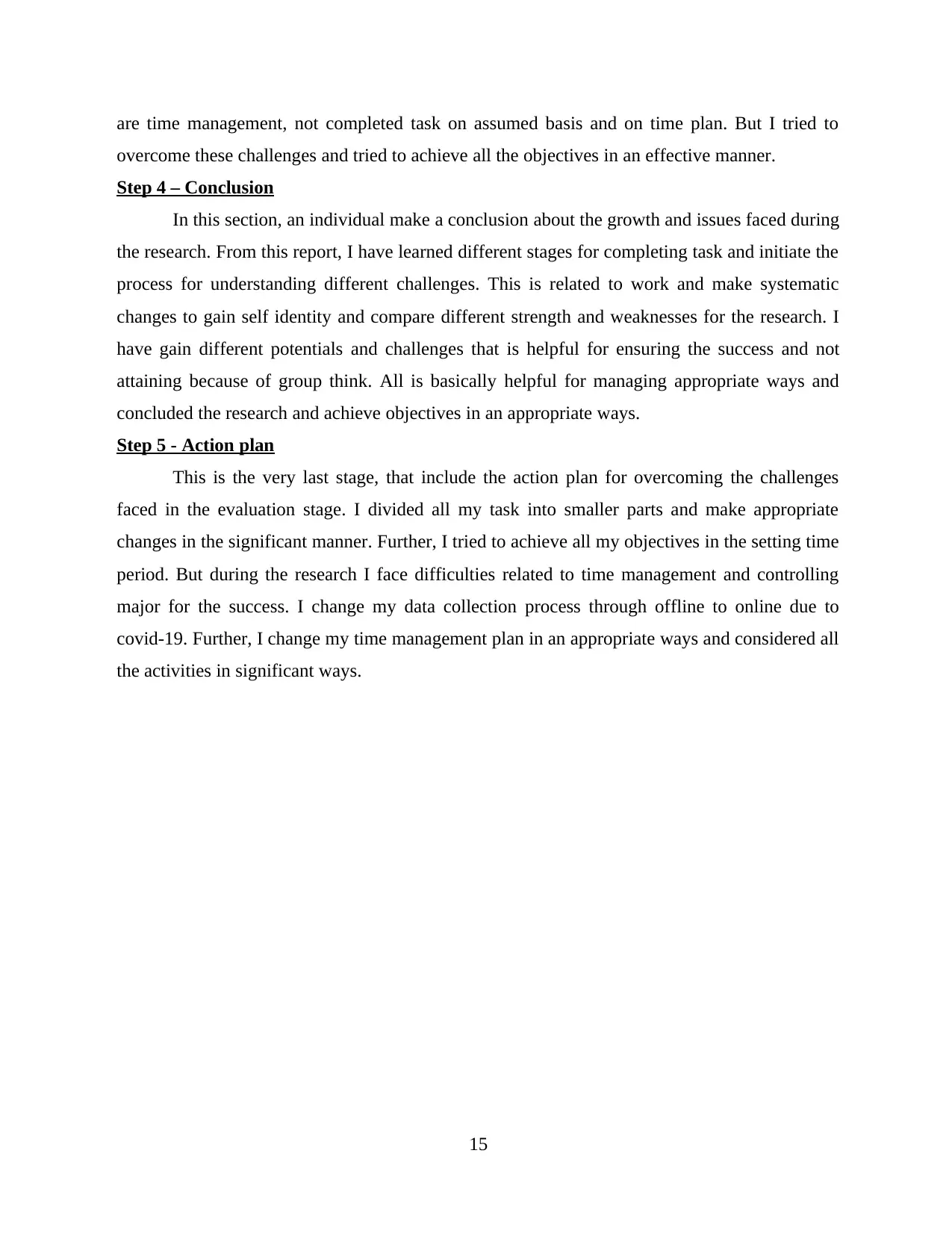
are time management, not completed task on assumed basis and on time plan. But I tried to
overcome these challenges and tried to achieve all the objectives in an effective manner.
Step 4 – Conclusion
In this section, an individual make a conclusion about the growth and issues faced during
the research. From this report, I have learned different stages for completing task and initiate the
process for understanding different challenges. This is related to work and make systematic
changes to gain self identity and compare different strength and weaknesses for the research. I
have gain different potentials and challenges that is helpful for ensuring the success and not
attaining because of group think. All is basically helpful for managing appropriate ways and
concluded the research and achieve objectives in an appropriate ways.
Step 5 - Action plan
This is the very last stage, that include the action plan for overcoming the challenges
faced in the evaluation stage. I divided all my task into smaller parts and make appropriate
changes in the significant manner. Further, I tried to achieve all my objectives in the setting time
period. But during the research I face difficulties related to time management and controlling
major for the success. I change my data collection process through offline to online due to
covid-19. Further, I change my time management plan in an appropriate ways and considered all
the activities in significant ways.
15
overcome these challenges and tried to achieve all the objectives in an effective manner.
Step 4 – Conclusion
In this section, an individual make a conclusion about the growth and issues faced during
the research. From this report, I have learned different stages for completing task and initiate the
process for understanding different challenges. This is related to work and make systematic
changes to gain self identity and compare different strength and weaknesses for the research. I
have gain different potentials and challenges that is helpful for ensuring the success and not
attaining because of group think. All is basically helpful for managing appropriate ways and
concluded the research and achieve objectives in an appropriate ways.
Step 5 - Action plan
This is the very last stage, that include the action plan for overcoming the challenges
faced in the evaluation stage. I divided all my task into smaller parts and make appropriate
changes in the significant manner. Further, I tried to achieve all my objectives in the setting time
period. But during the research I face difficulties related to time management and controlling
major for the success. I change my data collection process through offline to online due to
covid-19. Further, I change my time management plan in an appropriate ways and considered all
the activities in significant ways.
15
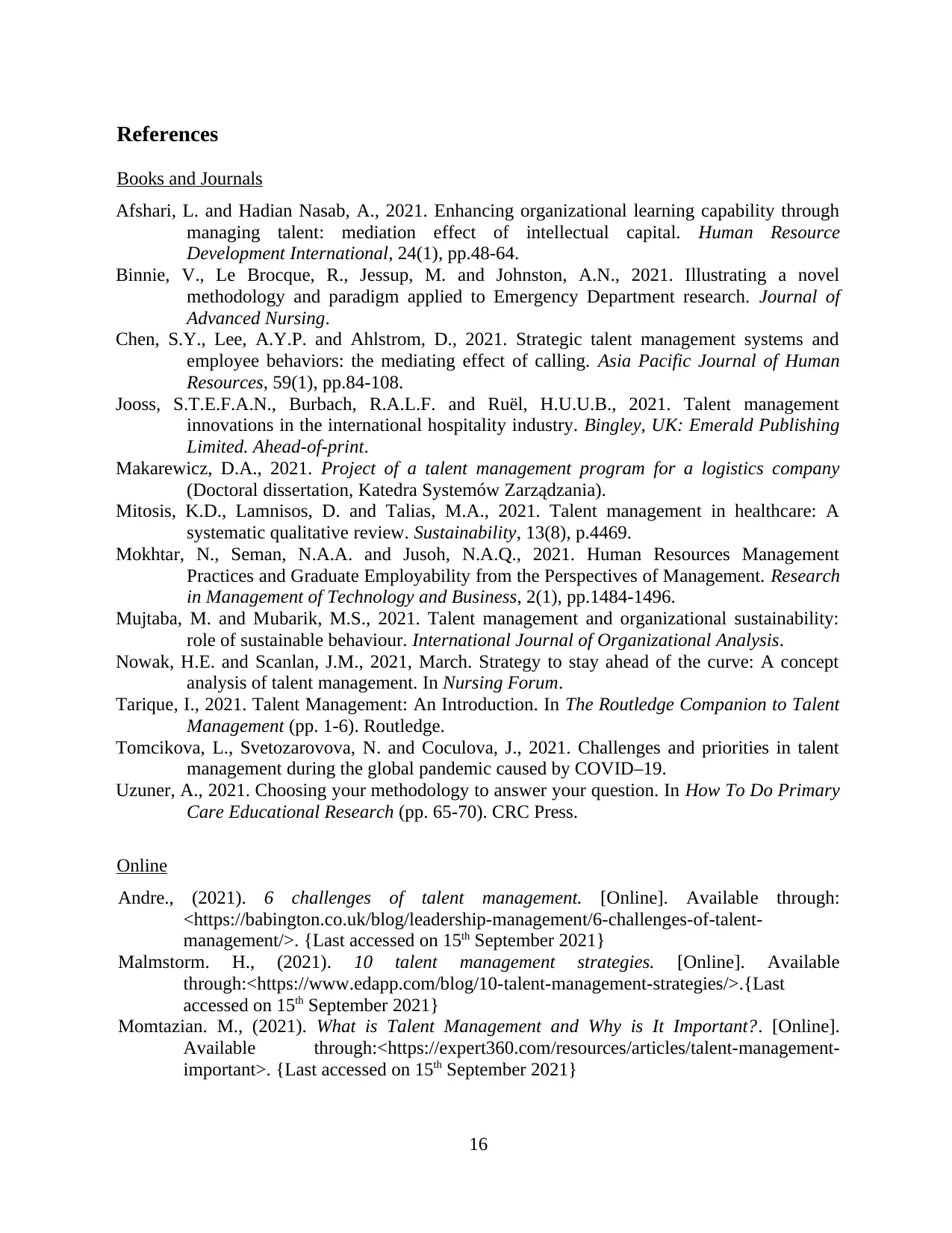
References
Books and Journals
Afshari, L. and Hadian Nasab, A., 2021. Enhancing organizational learning capability through
managing talent: mediation effect of intellectual capital. Human Resource
Development International, 24(1), pp.48-64.
Binnie, V., Le Brocque, R., Jessup, M. and Johnston, A.N., 2021. Illustrating a novel
methodology and paradigm applied to Emergency Department research. Journal of
Advanced Nursing.
Chen, S.Y., Lee, A.Y.P. and Ahlstrom, D., 2021. Strategic talent management systems and
employee behaviors: the mediating effect of calling. Asia Pacific Journal of Human
Resources, 59(1), pp.84-108.
Jooss, S.T.E.F.A.N., Burbach, R.A.L.F. and Ruël, H.U.U.B., 2021. Talent management
innovations in the international hospitality industry. Bingley, UK: Emerald Publishing
Limited. Ahead-of-print.
Makarewicz, D.A., 2021. Project of a talent management program for a logistics company
(Doctoral dissertation, Katedra Systemów Zarządzania).
Mitosis, K.D., Lamnisos, D. and Talias, M.A., 2021. Talent management in healthcare: A
systematic qualitative review. Sustainability, 13(8), p.4469.
Mokhtar, N., Seman, N.A.A. and Jusoh, N.A.Q., 2021. Human Resources Management
Practices and Graduate Employability from the Perspectives of Management. Research
in Management of Technology and Business, 2(1), pp.1484-1496.
Mujtaba, M. and Mubarik, M.S., 2021. Talent management and organizational sustainability:
role of sustainable behaviour. International Journal of Organizational Analysis.
Nowak, H.E. and Scanlan, J.M., 2021, March. Strategy to stay ahead of the curve: A concept
analysis of talent management. In Nursing Forum.
Tarique, I., 2021. Talent Management: An Introduction. In The Routledge Companion to Talent
Management (pp. 1-6). Routledge.
Tomcikova, L., Svetozarovova, N. and Coculova, J., 2021. Challenges and priorities in talent
management during the global pandemic caused by COVID–19.
Uzuner, A., 2021. Choosing your methodology to answer your question. In How To Do Primary
Care Educational Research (pp. 65-70). CRC Press.
Online
Andre., (2021). 6 challenges of talent management. [Online]. Available through:
<https://babington.co.uk/blog/leadership-management/6-challenges-of-talent-
management/>. {Last accessed on 15th September 2021}
Malmstorm. H., (2021). 10 talent management strategies. [Online]. Available
through:<https://www.edapp.com/blog/10-talent-management-strategies/>.{Last
accessed on 15th September 2021}
Momtazian. M., (2021). What is Talent Management and Why is It Important?. [Online].
Available through:<https://expert360.com/resources/articles/talent-management-
important>. {Last accessed on 15th September 2021}
16
Books and Journals
Afshari, L. and Hadian Nasab, A., 2021. Enhancing organizational learning capability through
managing talent: mediation effect of intellectual capital. Human Resource
Development International, 24(1), pp.48-64.
Binnie, V., Le Brocque, R., Jessup, M. and Johnston, A.N., 2021. Illustrating a novel
methodology and paradigm applied to Emergency Department research. Journal of
Advanced Nursing.
Chen, S.Y., Lee, A.Y.P. and Ahlstrom, D., 2021. Strategic talent management systems and
employee behaviors: the mediating effect of calling. Asia Pacific Journal of Human
Resources, 59(1), pp.84-108.
Jooss, S.T.E.F.A.N., Burbach, R.A.L.F. and Ruël, H.U.U.B., 2021. Talent management
innovations in the international hospitality industry. Bingley, UK: Emerald Publishing
Limited. Ahead-of-print.
Makarewicz, D.A., 2021. Project of a talent management program for a logistics company
(Doctoral dissertation, Katedra Systemów Zarządzania).
Mitosis, K.D., Lamnisos, D. and Talias, M.A., 2021. Talent management in healthcare: A
systematic qualitative review. Sustainability, 13(8), p.4469.
Mokhtar, N., Seman, N.A.A. and Jusoh, N.A.Q., 2021. Human Resources Management
Practices and Graduate Employability from the Perspectives of Management. Research
in Management of Technology and Business, 2(1), pp.1484-1496.
Mujtaba, M. and Mubarik, M.S., 2021. Talent management and organizational sustainability:
role of sustainable behaviour. International Journal of Organizational Analysis.
Nowak, H.E. and Scanlan, J.M., 2021, March. Strategy to stay ahead of the curve: A concept
analysis of talent management. In Nursing Forum.
Tarique, I., 2021. Talent Management: An Introduction. In The Routledge Companion to Talent
Management (pp. 1-6). Routledge.
Tomcikova, L., Svetozarovova, N. and Coculova, J., 2021. Challenges and priorities in talent
management during the global pandemic caused by COVID–19.
Uzuner, A., 2021. Choosing your methodology to answer your question. In How To Do Primary
Care Educational Research (pp. 65-70). CRC Press.
Online
Andre., (2021). 6 challenges of talent management. [Online]. Available through:
<https://babington.co.uk/blog/leadership-management/6-challenges-of-talent-
management/>. {Last accessed on 15th September 2021}
Malmstorm. H., (2021). 10 talent management strategies. [Online]. Available
through:<https://www.edapp.com/blog/10-talent-management-strategies/>.{Last
accessed on 15th September 2021}
Momtazian. M., (2021). What is Talent Management and Why is It Important?. [Online].
Available through:<https://expert360.com/resources/articles/talent-management-
important>. {Last accessed on 15th September 2021}
16
Secure Best Marks with AI Grader
Need help grading? Try our AI Grader for instant feedback on your assignments.
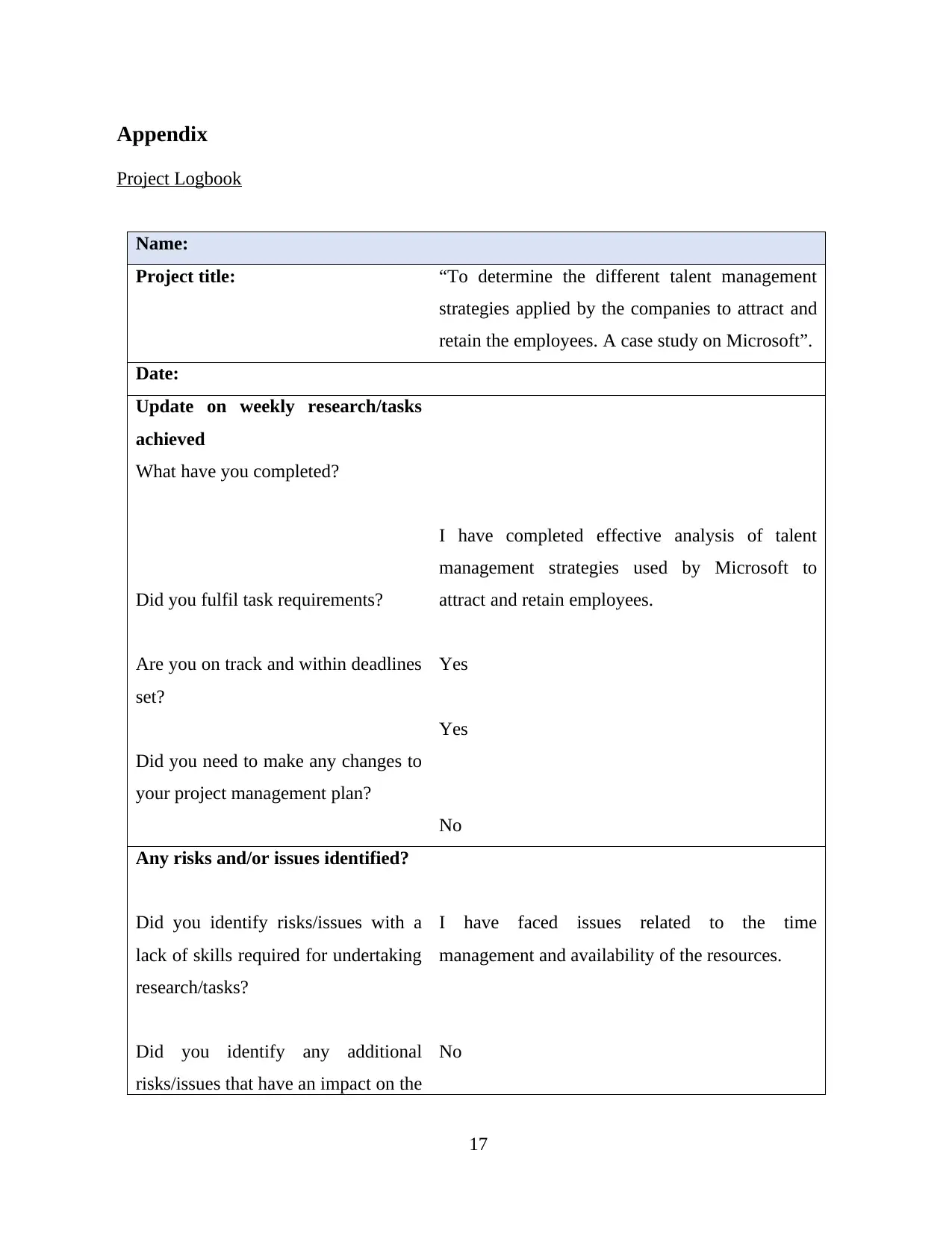
Appendix
Project Logbook
Name:
Project title: “To determine the different talent management
strategies applied by the companies to attract and
retain the employees. A case study on Microsoft”.
Date:
Update on weekly research/tasks
achieved
What have you completed?
Did you fulfil task requirements?
Are you on track and within deadlines
set?
Did you need to make any changes to
your project management plan?
I have completed effective analysis of talent
management strategies used by Microsoft to
attract and retain employees.
Yes
Yes
No
Any risks and/or issues identified?
Did you identify risks/issues with a
lack of skills required for undertaking
research/tasks?
Did you identify any additional
risks/issues that have an impact on the
I have faced issues related to the time
management and availability of the resources.
No
17
Project Logbook
Name:
Project title: “To determine the different talent management
strategies applied by the companies to attract and
retain the employees. A case study on Microsoft”.
Date:
Update on weekly research/tasks
achieved
What have you completed?
Did you fulfil task requirements?
Are you on track and within deadlines
set?
Did you need to make any changes to
your project management plan?
I have completed effective analysis of talent
management strategies used by Microsoft to
attract and retain employees.
Yes
Yes
No
Any risks and/or issues identified?
Did you identify risks/issues with a
lack of skills required for undertaking
research/tasks?
Did you identify any additional
risks/issues that have an impact on the
I have faced issues related to the time
management and availability of the resources.
No
17
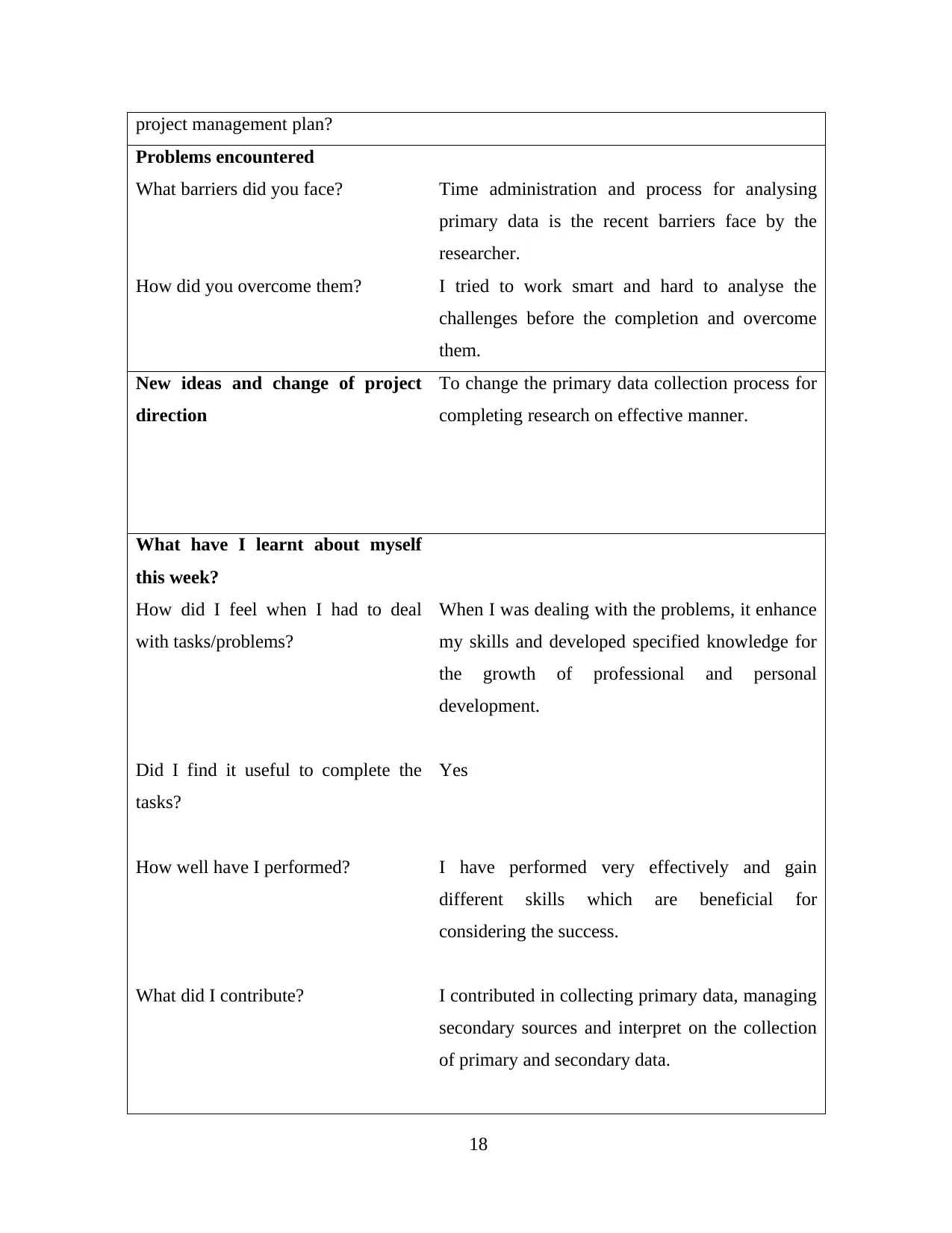
project management plan?
Problems encountered
What barriers did you face?
How did you overcome them?
Time administration and process for analysing
primary data is the recent barriers face by the
researcher.
I tried to work smart and hard to analyse the
challenges before the completion and overcome
them.
New ideas and change of project
direction
To change the primary data collection process for
completing research on effective manner.
What have I learnt about myself
this week?
How did I feel when I had to deal
with tasks/problems?
Did I find it useful to complete the
tasks?
How well have I performed?
What did I contribute?
When I was dealing with the problems, it enhance
my skills and developed specified knowledge for
the growth of professional and personal
development.
Yes
I have performed very effectively and gain
different skills which are beneficial for
considering the success.
I contributed in collecting primary data, managing
secondary sources and interpret on the collection
of primary and secondary data.
18
Problems encountered
What barriers did you face?
How did you overcome them?
Time administration and process for analysing
primary data is the recent barriers face by the
researcher.
I tried to work smart and hard to analyse the
challenges before the completion and overcome
them.
New ideas and change of project
direction
To change the primary data collection process for
completing research on effective manner.
What have I learnt about myself
this week?
How did I feel when I had to deal
with tasks/problems?
Did I find it useful to complete the
tasks?
How well have I performed?
What did I contribute?
When I was dealing with the problems, it enhance
my skills and developed specified knowledge for
the growth of professional and personal
development.
Yes
I have performed very effectively and gain
different skills which are beneficial for
considering the success.
I contributed in collecting primary data, managing
secondary sources and interpret on the collection
of primary and secondary data.
18
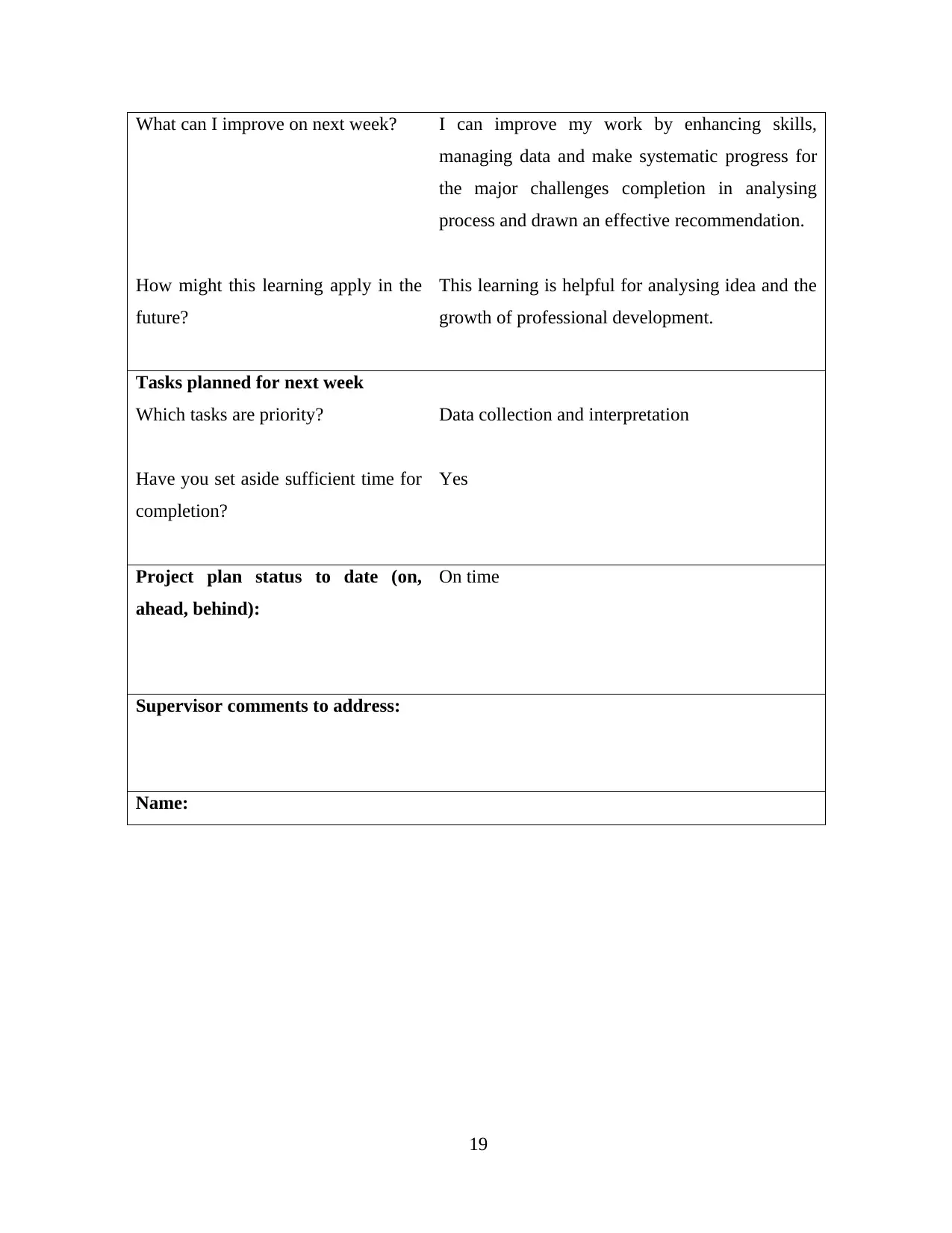
What can I improve on next week?
How might this learning apply in the
future?
I can improve my work by enhancing skills,
managing data and make systematic progress for
the major challenges completion in analysing
process and drawn an effective recommendation.
This learning is helpful for analysing idea and the
growth of professional development.
Tasks planned for next week
Which tasks are priority?
Have you set aside sufficient time for
completion?
Data collection and interpretation
Yes
Project plan status to date (on,
ahead, behind):
On time
Supervisor comments to address:
Name:
19
How might this learning apply in the
future?
I can improve my work by enhancing skills,
managing data and make systematic progress for
the major challenges completion in analysing
process and drawn an effective recommendation.
This learning is helpful for analysing idea and the
growth of professional development.
Tasks planned for next week
Which tasks are priority?
Have you set aside sufficient time for
completion?
Data collection and interpretation
Yes
Project plan status to date (on,
ahead, behind):
On time
Supervisor comments to address:
Name:
19
1 out of 19
Related Documents
Your All-in-One AI-Powered Toolkit for Academic Success.
+13062052269
info@desklib.com
Available 24*7 on WhatsApp / Email
![[object Object]](/_next/static/media/star-bottom.7253800d.svg)
Unlock your academic potential
© 2024 | Zucol Services PVT LTD | All rights reserved.

